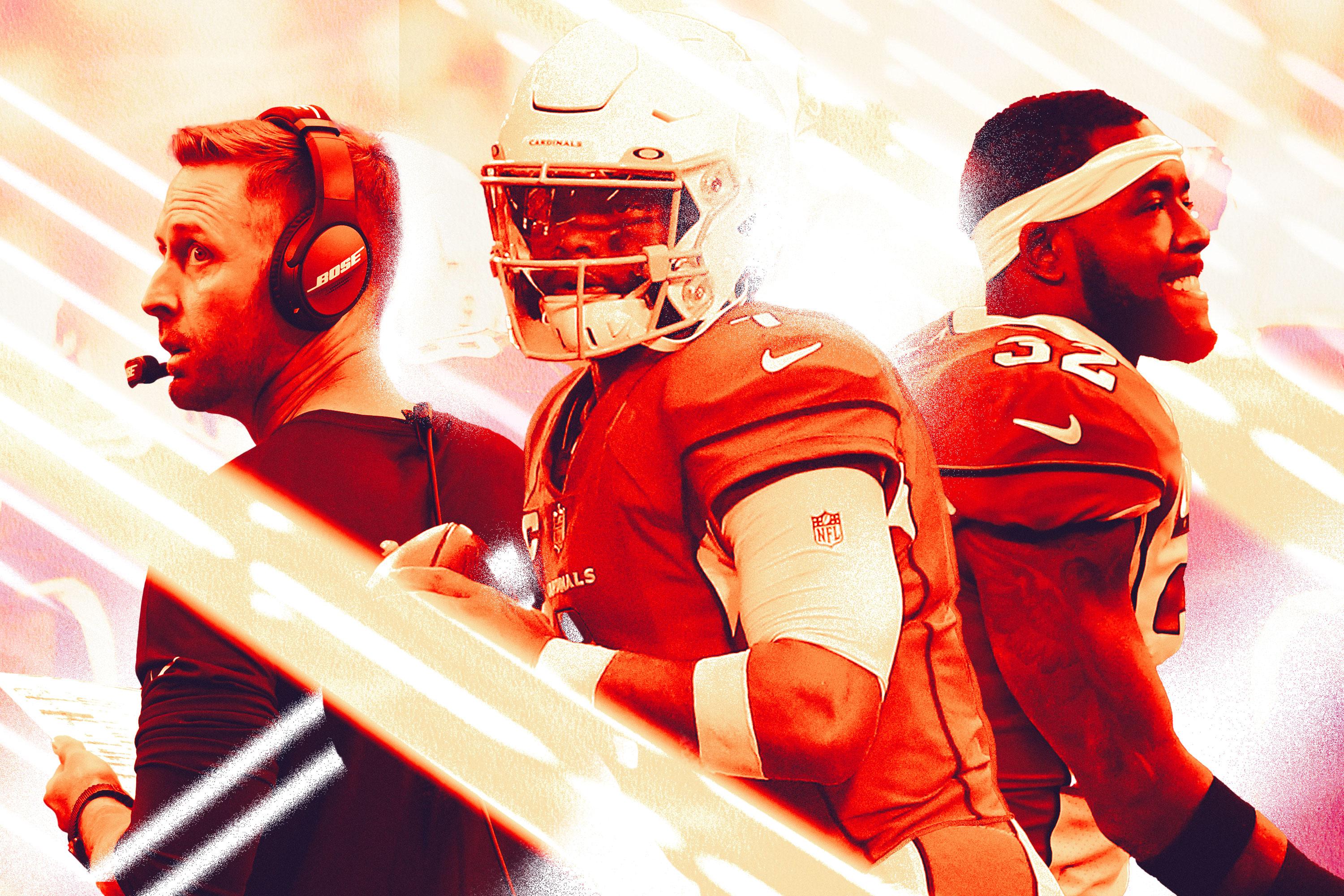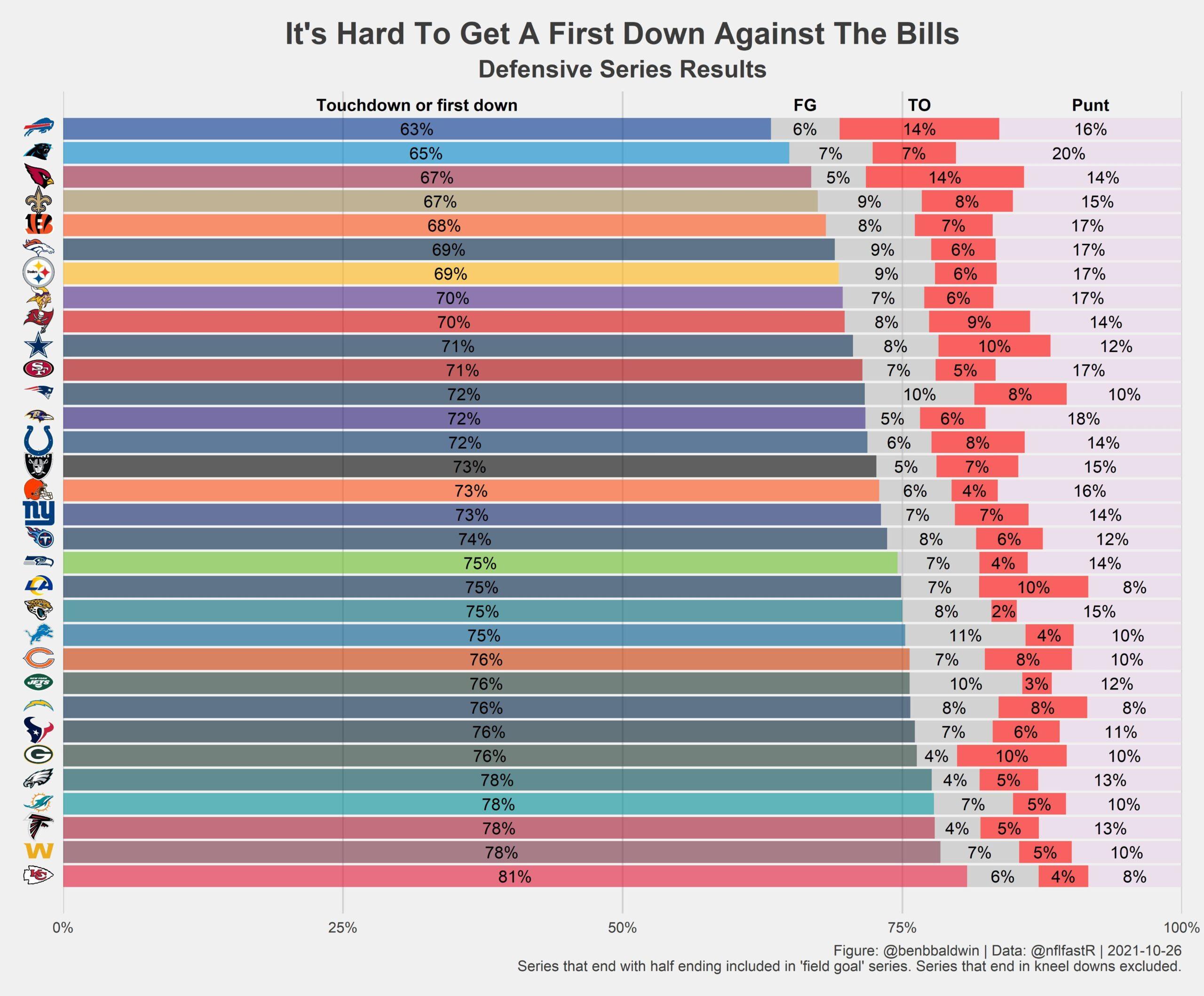
The Cardinals are the NFL’s last undefeated team. Not the Chiefs or the Buccaneers or the Packers or the Bills. The Cardinals.
Apologies to the state of Arizona if I sound a little shocked by that development, but I’m not alone. Before the start of the season, only nine teams had longer odds than the Cardinals to be the league’s last undefeated team. Even Arizona’s more optimistic fans probably didn’t expect them to be sitting at 7-0—with wins over teams like the Rams and 49ers—at the end of October.
But the team started off strong in almost every regard. Arizona is second in the league in DVOA and is the only team that ranks in the top five in both expected points added and EPA allowed. The Cardinals also have the NFL’s best point differential and own double-digit wins over the Rams, Titans, and Browns. They have undoubtedly been good … but the underlying numbers suggest they’ve also been lucky to have this undefeated record, which should naturally lead to questions about just how sustainable their dominant start is.
The Cardinals have question marks on both sides of the ball. On offense, they’ve been too reliant on third down, which is usually a sign of looming regression. They’ve essentially been a different unit on each down, going from bad on first down, to pretty good on second, to defense-devouring monster on third and fourth.
Cardinals Offensive DVOA by Down
Third-down success is obviously important in the NFL—punts are bad!—but the best teams avoid third downs altogether. The Cardinals are doing that at a relatively good rate (57 percent) this season, but the bar needs to be much higher than “relatively good” if you’re talking about a team with Super Bowl aspirations.
In addition to those impressive third-down figures, Arizona’s offense has also been unsustainably good at recovering its own fumbles. The Cardinals have coughed the ball up 12 times so far this season, and they’ve managed to recover it 11, per Football Outsiders. One of the first lessons we learned from the early football analytics movement is that, over a larger sample, a team’s fumble-recovery rate should even out to about a 50-50 split. So don’t expect this good fortune to continue.
The defense is also enjoying its fair share of turnover luck. The Cardinals are forcing turnovers at the same rate they’re forcing punts right now (14 percent), which almost certainly won’t last. “Turnovers forced” tends to be one of the more volatile team metrics out there.

It’s not just the turnover thing, either. Like the offense, the Cardinals defense has also been a machine on third down. Per RBSDM.com, they’re preventing third-down conversions at an NFL-leading rate of 28.8 percent, which is 12.6 percent above expectation based on “leaguewide average at a given yards to go.” Sure, we should expect good defenses to perform above the league average, but third-down stats are notoriously flakey. And this stat in particular tells us very little about how a team will perform in the future. For instance, the Bears led the league in the same metric halfway through the 2020 season; over the second half, though, they ranked fourth from the bottom. Yes, it’s possible that the Cardinals could continue at this torrid pace—it’s just not especially likely.
At this point, you probably think you have a good idea of where this article is going. I’ve painted a pretty dour picture of a team that’s atop the league standings, and with all that information in hand, it’d be pretty easy to say this is all going to come crashing down over the next two months. But what if the Cardinals didn’t just stumble into their volatile brand of football? What if this is all by design?
As unlikely as that sounds, a deeper interrogation of the numbers above and examination of the team’s film and various player and coach interviews makes it seem like this was the plan all along. Let’s start with the offense and its performance on first down. Here’s a chart from Pro Football Focus’s Timo Riske that shows just how poorly Arizona is operating on first down compared to later downs:

The chart shows that most of the top offenses tend to do a lot of damage on first down, with the glaring exception of Arizona. The Cardinals are moving the chains at an 18 percent rate on first down. Only the Texans are worse in that regard.
So why is that happening? Well, Kyler Murray doesn’t generally look to push the ball downfield on first down. He’s attempted 58 passes short of the sticks on first down, and his average depth of target on those plays is just 0.5 yards, which ranks last in the league, per Sports Info Solutions. Meanwhile, Murray has attempted only 20 passes (tied for 22nd in the league) beyond the marker on first down, and his average depth of target is 20.5 yards, which ranks fifth.
In other words, Kliff Kingsbury is either going to call a shot play—typically off play-action—or get the ball out Murray’s hands in an instant, and he does that by calling a whole lot of RPOs. That approach makes sense with a quarterback like Murray, who takes sacks at a high rate. The goal is clear: limit negative plays early and let Kyler be Kyler on third down, when there isn’t much difference between a long fourth down and a really long fourth down.
Kingsbury deserves credit for tweaking his RPO designs to increase the chances that they’ll turn into big plays. Rather than trotting out the endless stream of bubble screens we saw last year, the Cardinals are throwing beyond the line of scrimmage on those RPO plays. Per Sports Info Solutions, Arizona’s average depth of catch on RPO plays has jumped from minus-0.3 in 2020 to 2.8 in 2021. As a result, its EPA per target on RPOs has spiked, as has its explosive play rate.
Cardinals RPO, 2020 vs. 2021
So the Cardinals haven’t necessarily been bad on first down; they’ve just been a little conservative. And that conservatism has set them up for success on second and third down by making things a lot easier. The Cardinals have managed to stay in favorable down-and-distances at a fairly consistent rate, tied for 12th in “average yards to go” on second down at 7.6 yards, per Stathead. They also lead the league in first-down rate on second down, despite ranking tied for eighth in yards per play on that down.
When the Cardinals do get to third down, that’s when it’s Kyler time. If DeAndre Hopkins, Christian Kirk, A.J. Green, and now Zach Ertz can’t get open initially, Kyler can either buy time for them to do so or just pick up the first down with his legs. And that’s not the only way he can win—at least not now that his game has evolved in Year 3. In addition to those magical plays that only a handful of other quarterbacks can even dream of making, Kyler has added some crafty tricks that help less mobile quarterbacks create openings.
Take this miracle third-down conversion from Sunday’s win over the Texans. Arizona needs 24 yards to move the chains, and Houston is playing a soft zone coverage to prevent that. Murray wants to hit Green down the sideline, but the safety is in position to break on the pass. So the Cardinals quarterback takes a little jab step in the direction of Kirk, who’s running straight down the middle, and that draws the safety just enough to open up the throwing window to Green.
It’s a jaw-dropping display of arm talent, but that throw doesn’t get past the safety without Murray’s eye manipulation. We didn’t see that from the 2019 first pick in years 1 and 2. Now it shows up fairly regularly. Here’s another example from Sunday:
We’ve reached the point when we can probably say that Murray’s ridiculous play out of structure is repeatable, in the same way that it’s been for Russell Wilson and Patrick Mahomes, two quarterbacks who play the position in a similar manner. He’s that talented.
But what about the defense? It can’t possibly keep creating takeaways and preventing third-down conversions at this same pace, right?
I’m not so sure. Defensive coordinator Vance Joseph is applying the inverse of the philosophy that Kingsbury is using on the other side of the ball. In other words, he’s doing everything in his power to create negative plays on first down in order to put the offense in adverse conditions on second and third.
Joseph has been at his most aggressive on first down, at least in terms of blitzing. According to Next Gen Stats, Arizona’s blitz rate is 35 percent on first down, which ranks second in the NFL and is actually higher than the team’s blitz rate on third down, the time when defenses typically like to gamble. But these early-down blitzes aren’t necessarily designed to get sacks; they’re designed to attack the favored run concepts of Arizona’s opponents. This one allows J.J. Watt to slant inside and take on the pulling guard to blow up a run in the backfield:
This one sends safety Budda Baker screaming off the edge to tackle the ballcarrier for a minimal gain:
Joseph has his front attacking on every down, and that aggressive approach has led to volatile results. Just looking at tackles made by Arizona’s front seven (so just linebackers and defensive linemen), the unit ranks ninth in stuff rate—or runs that don’t make it past the line of scrimmage—but 31st in average yards allowed. It’s an all-or-nothing approach, and Joseph doesn’t mind giving up yards if his team has a better chance of creating a game-altering play.
“Yards, in this league, are always going to be tough to keep low because everyone is moving the ball,” Joseph said after the team’s Week 6 win in Cleveland. “That’s not a concern for me. It’s really those areas that hold points to a minimum: It’s always the red zone, third down, takeaways, sacks, passing yards, and interceptions—those things matter. Teams are going to move the ball on you; it’s NFL football. … Right now, those areas we’re really good at.”
That’s a message he’s clearly relayed to his team. After the win over Houston, second-year linebacker Isaiah Simmons explained how important winning on first down is to the overall defensive philosophy.
“It all starts on first down,” Simmons said. “Especially with a team like [Houston], their objective is to get into second-and-short, where they can run the ball still [or] they can throw the ball. Controlling first downs, keeping them in second-and-long, it makes it easier for us. Because then we can let our pass rushers go, and let our cover guys just cover. … When the game is like that, it’s in our favor.”
Baker echoed that sentiment, mentioning how first-down success allows the Cardinals to do more schematically later on in a series of downs.
That “crazy scheme” stuff Baker is talking about isn’t necessarily referring to exotic blitzes, though Joseph isn’t afraid to send the house at any time. But the Cardinals generally take a safer approach to pressuring the quarterback on third down. They run a lot of “creepers” and “simulated pressure”—defensive designs that look like blitzes but are actually just four-man rushes played in front of conservative zone coverages. The defense will blitz nontraditional pass rushers, like defensive backs and linebackers, but drop defensive ends and tackles into coverage.

That creates confusion for both the quarterback and the offensive line. Here’s an example from the Texans game. The Cardinals end up sending only four rushers against Houston’s five-man pass-protection unit, but still end up with two free rushers because the offensive line is preoccupied by guys dropping into coverage:
The result is a hurried throw to a receiver who is quickly tackled before the first-down marker. Again, this is all by design—the plan was to create chaos in front of rookie Davis Mills and force him to get rid of the ball prematurely.
“It’s kind of expected with a rookie quarterback,” Simmons said. “He’s not going to sit back there like Aaron Rodgers and just go through all the progressions. I mean some rookies can, but it’s tough. Especially with guys like Budda and [Jalen Thompson]. They’re giving looks where you don’t know what they’re playing. Sometimes I’m like, ‘Wait, what are you doing?’”
Well, it’s fitting that Rodgers was the counter-example Simmons chose, as his (banged-up) Packers are next up on the Cardinals’ schedule. Given Rodgers’s command of the Green Bay offense, the 2020 MVP should be the perfect test for this chaos-based defense. It’s one thing to fool Mills or even Baker Mayfield; it’s a lot harder to outwit Rodgers. And the Cardinals have spent the week talking about that very challenge.
Playing this Packers team—even if it’s missing wide receivers Davante Adams and Allen Lazard, and defensive coordinator Joe Barry—offers this up-and-coming Cardinals team another chance to land a signature win over a fellow contender for home-field advantage in the playoffs. And they’ll have to overcome their own personnel issues to do it, with J.J. Watt likely out for the season with a shoulder injury. Arizona has already managed to win games without Chandler Jones, who returns from the COVID-19 list this week, and Kingsbury, who landed on the same list ahead of the Browns game. But this is a playoff-tested Packers team that has won six in a row. It’s a different type of challenge.
If Arizona passes this test, it will be difficult to keep questioning the team’s credentials as a Super Bowl contender. There’s no reason to think Murray won’t continue to play at an MVP level, which by itself is typically enough to give a team a great chance at making a deep playoff run. If you throw in a legitimately good defense on top of that, you have to be considered one of the favorites to win it all. So, sure, Arizona has been a little lucky this season, but its coaches have helped create some of that “luck.” And if it’s better to be lucky than good, then being lucky and good is an ideal place to be.

